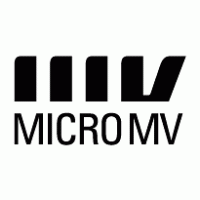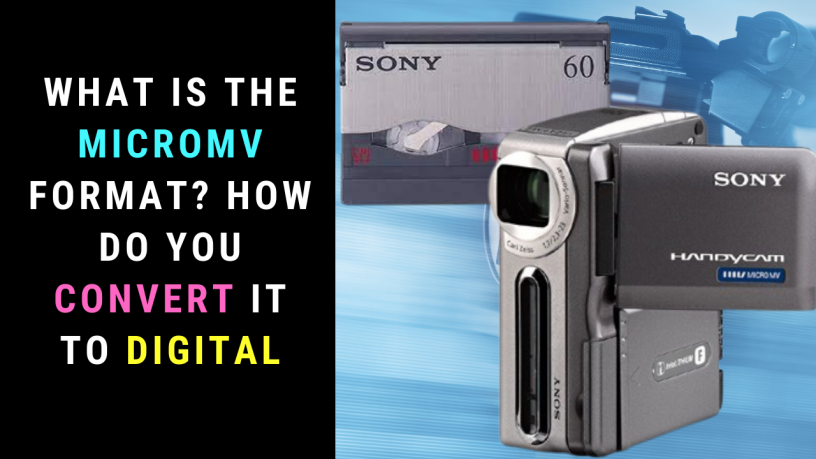Last updated on April 5th, 2024 at 03:12 am
The MicroMV format was created by Sony in 2001.

It’s a Sony proprietary tape format like Video8, Hi-8, and Digital8.
The MicroMV tape is, however, much smaller than Sony’s 8mm tapes and MiniDV tapes.
MicroMV uses digital encoding similar to that of DVD. Recordings are encoded in MPEG-2. As such, it’s often called the tape version of DVD.
MicroMV Advantages
Size and Weight
The standout advantage of MicroMV is size. Sony calls its MICROMV™ Digital Handycam camcorders the smallest and lightest camcorders in the world.
The tape is 70% smaller than a mini-DV tape. On the weight side, MicroMV camcorders are 60% lighter than 8mm camcorders.
The camcorders are small enough to be carried in your pocket. You can easily pack a MicroMV camcorder into your briefcase and tote bag.
MicroMV camcorders fit the palm and are hardly noticeable. This is useful for shooting in situations where you don’t want to draw attention.
Storage Space and Firewire Connection
Less computer space is needed to store video as video footage is compressed in MPEG-2. MPEG-2 video footage takes up less space than DV25 footage captured by a mini-DV camcorder.
Apart from S-Video and RCA/Composite ports, a MicroMV camcorder comes with an IEEE1394 (iLINK) port. This allows you to capture footage directly to a Firewire-enabled computer without the need for an external capture card.
Easy-to-Use Software
With MicroMV, you don’t have to worry about purchasing video editing software.
A MicroMV camcorder comes equipped with Sony’s video editing software, MovieShaker.
MovieShaker takes random clips from your recordings and ‘shakes’ them up. The result is you get a 30-second video.
Below is an example of a video that has been ‘shaken’ by MovieShaker.
MicroMV Disadvantages
A MicroMV tape lasts for a maximum duration of 60 minutes.
Video quality is much lower than that of mini-DV.
You can only playback MicroMV tape only on a MicroMV camcorder.
The MPEG-2 codec used for recording is proprietary to Sony. You can only access it through Sony’s MovieShaker Software.
The MPEG-2 format is not ideal for editing as opposed to the DV format.
MIcroMV tapes are more expensive than mini-DV tapes.
MicroMV camcorders will not work with any other software except Sony’s proprietary Movie Shaker.
The MicroMV format doesn’t work with Mac computers. It’s a Windows-based format.
Also, you can’t connect a MicroMV camcorder to a mini-DV camcorder through the available Firewire connection.
MicroMV Camcorder
No new MicroMV camcorders are manufactured. The last model was reported to be sold in 2006.
Still, you can find used MicroMV camcorders online, especially if you need a playback device for your MicroMV tapes.
An example is the Sony DCRIP5 MicroMV Digital Camcorder.
Among the features you can enjoy with a MicroMV camcorder are:
- Good image quality through Sony’s high-grade Carl Zeiss® Vario-Sonnar Lens
- Capture distant scenes with 10X optical/120X precision digital zoom
- Superior image quality through its advanced HAD CCD image sensor boasting 680K pixels
- Digital still memory mode is available through Memory Stick® media
- Shoot in MPEG AD movie mode
- USB connection meant for still images and MPEG1 video saved on Memory Stick® media
- Preview your recording through a 2.5″ SwivelScreen™ Precision Hybrid LCD with a resolution of 211K pixels
- Enjoy non-shaky videos with the Super SteadyShot Picture stabilization feature

To get a closer look at a MicroMV camcorder, check out the video below.
Sony MicroMV Tape
Being a proprietary format, MicroMV tapes are only manufactured by only Sony. No new tapes are in production since 2016. You can find MicroMV tapes for sale online though.
Sony’s MGR60 MicroMV videotape comes with a 64Kbit IC Memory Chip. The memory chip provides 16 times the memory available on a high-grade mini-DV cassette tape.
This chip allows for multi-picture search and index titling. Useful when you’re reviewing shot videos.
Every time you hit the Record button, the chip captures and stores an index picture. The pictures are available just like images on a DVD menu. You can access any of these clips by clicking on your preferred scene.
As for index titling, you can give any scene a preset or custom title in a color of your choice.
The chip also allows you to record additional information on the videocassette. Multi-search logic is enabled. This feature allows you to access different parts of the tape, as you would on a DVD as has been explained above. How is this possible? Access is provided through thumbnail image copies of recorded footage on the tape.
On inserting a MicroMV tape into the camcorder, such information as date of first use, date of last use, balance recording space, and titling capability is shown on the LCD screen automatically.
Check out this minuscule Sony 60 Minute MicroMV Digital Tape with Chip.

MicroMV Adapter
If you don’t have a MicroMV camcorder, is there a MicroMV adapter you can use to playback MicroMV tape on other devices like VHS, 8mm, and mini-DV players?
Unfortunately, there is no such adapter. You would have to use a MicroMV camcorder to playback the tape.
Converting MicroMV Tapes to Digital or DVD
The process of converting a MicroMV tape to digital is very much like converting any other tape format to digital. In the case of MIcroMV, a digital connection is available via Sony iLINK, or IEEE1394, or Firewire.
Through a computer with a Firewire port, you can connect the MicroMV camcorder and capture and edit your video footage through the MICROMV MovieShaker™ program.
After editing you can copy your footage to tape or burn them to CD and DVD.
According to the video below, it’s not easy to find the MovieShaker software. However, a check revealed that Sony has uploaded a copy to the Internet Archive.
It is mentioned that MovieShaker works with Microsoft Windows 2000 Professional, Microsoft Windows Millennium Edition (Windows ME), and Microsoft Windows XP Home/Professional.
Sony also mentions that MovieShaker 3.1 works only with your computer’s factory-installed Microsoft XP operating system.
If you don’t fancy MovieShaker, the video below provides an alternative in the form of CapDVHS.
CapDVHS does a good job in converting MicroMV to digital as demonstrated in the video below.
The other video capture/editing software programs mentioned at Internet Archive that can convert MicroMV to digital include:
- Vegas Movie Studio-Supports capturing video from MicroMV camcorders (in HDV mode).
- Sony’s DVgate Plus has support MicroMV capture
- Pinnacle Studio 8/9—Captures MicroMV and allows for editing and creating DVD
- GrabMV—Captures MicroMV clips.
- Apple iMovie ’08 to ’11 for Mac importing footage MicroMV camcorders. Not available in iMovie 10.x.
- Ulead DVD Workshop 2—plugin available for MicroMV capture
- Ulead VideoStudio 7/8/9 captures MicroMV
MicroMV to Digital Service
If you have a MicroMV tape or two you wish to convert to digital, you may want to use a tape to digital service in your neighbourhood.
If you can’t find one, you may want to use an online tape to digital conversion service.
MicroMV Bites the Dust
The MicroMV format lost out to the emerging HD format. Plus it is not as convenient as the mini-DV format which can be played back by any mini-DV camcorder or tape player. Capturing video and editing it is also a pain. Pros won’t touch it with a barge pole.
Size and weight alone weren’t enough to convince consumers that it’s a camcorder format they should embrace.
Sony stopped production of MicroMV camcorders in 2006.
In 2016, it announced that it’s ceasing production of MicroMV tapes, alongside Betamax tapes.
References
MovieShaker v. 3.1 at Internet Archive
The Complete Guide to Digital Video By Ed Gaskell



